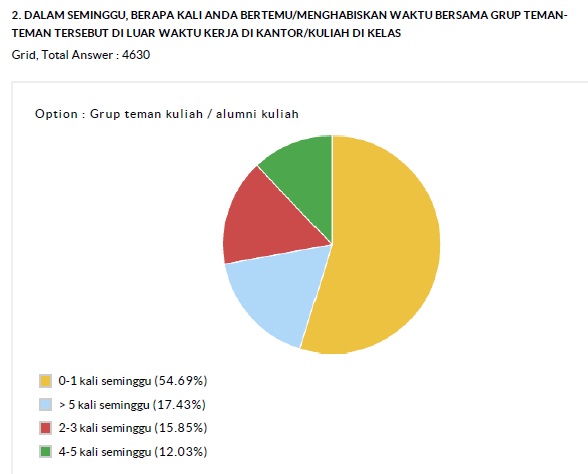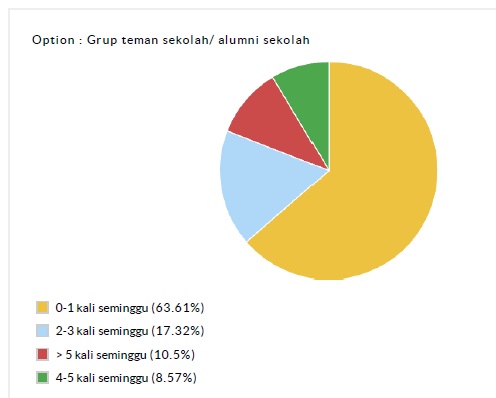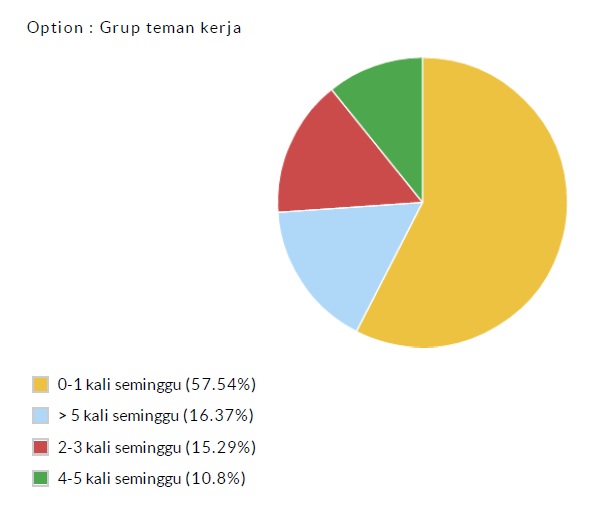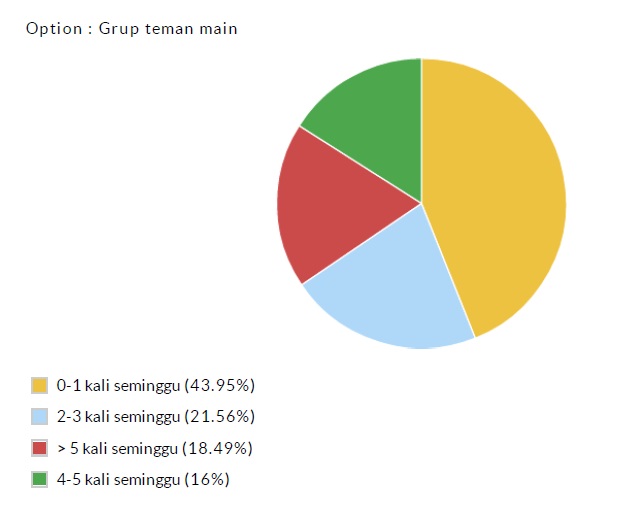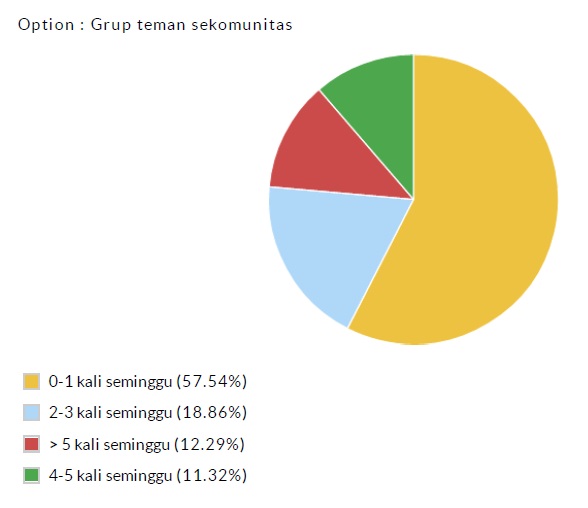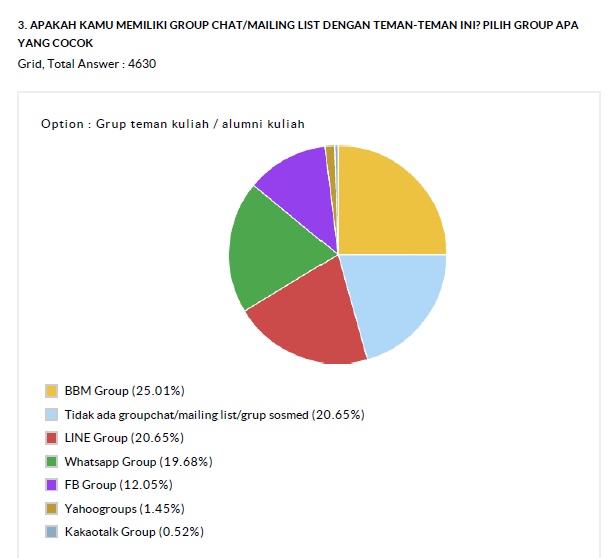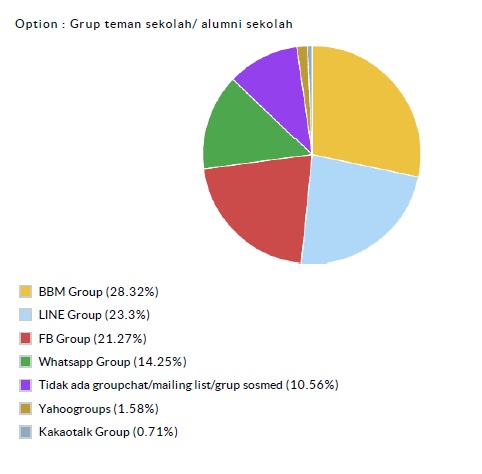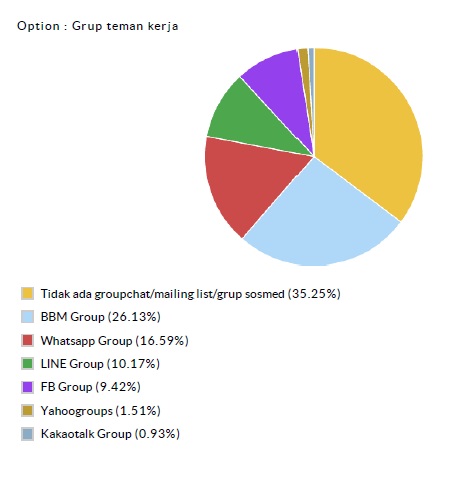From the moment that a baby is born in the world, he or she is socialized to develop relationships with others. Sometimes, the labels are already there – mother, father, sister, brother, grandmother. For those without set labels, those people are grouped into the umbrella category of “friends.” As people navigate through their lives, they encounter more and more people which means more and more opportunities for making friends. After all, friends are generally defined as those who are good and compatible with you which means that can be of any age, sex, gender, background, etc.
With so many acquaintances, we wanted to know who makes up people’s circle of friends, how often they meet in a meet and what tools they use to communicate with one another. This survey was followed by 4527 respondents.
Circle of Friends
First, we wanted to know which groups people consider themselves a part of in terms of friendships.
Most people (70.39%) would say that they are still connected to friends from elementary, junior high and senior high schools. More than half (59.81%) say that their social circle includes friends from university, 44.38% from the same communities. Respondents also have social friends that they hang out with (44.17%), and 34.86% say that their circle of friends includes co-workers.
Although both men and women stated that their social circle includes friends from primary and secondary schools as well as college, it seems that women are likelier to maintain these friendships. To start off, 74.22% of female respondents reported having primary and secondary school classmates in their circle of friends whereas only 66.68% of male respondents said the same thing. Although smaller, 68.59% of female respondents said that their friendship groups include friends from university, while just a little over half of male respondents (51.69%) said the same. Men reported more likely than women to have friends from work (38.82% vs. 30.87%), social friends (46.45% vs. 42.05%) and interest communities (47.57% vs. 41.42%).
| Q1 (multiple answer) : Menurut anda, anda memiliki/ tergabung grup pertemanan apa saja? ( Pilih yang cocok) | Total | Gender | |
| Male n=2308 | Female n=2219 | ||
| Option 1 : Grup teman kuliah | 2715 | 1193 | 1522 |
| 59.97% | 51.69% | 68.59% | |
| Option 2 : Grup teman sekolah / alumni sekolah | 3186 | 1539 | 1647 |
| 70.38% | 66.68% | 74.22% | |
| Option 3 : Grup teman kerja | 1581 | 896 | 685 |
| 34.92% | 38.82% | 30.87% | |
| Option 4 : Grup teman main | 2005 | 1072 | 933 |
| 44.29% | 46.45% | 42.05% | |
| Option 5 : Grup teman sekomunitas | 2017 | 1098 | 919 |
| 44.55% | 47.57% | 41.42% | |
| Option 6 : Other | 119 | 43 | 76 |
| 2.63% | 1.86% | 3.42% | |
Based on age breakdowns, here are the trends that we found for the different groups of friendship circles.
- Friends from university – The strongest age bracket that indicated having these friends in their current social network is 20-25 which 70.58% respondents in that age bracket saying so. As people get older, these friendships tend to be on the decline.
- Friends from primary and secondary schools - Generally, the younger respondents are more likely to have stronger connections. However, it seems that generally, people still keep in touch with some friends from their childhood as more than half of respondents in all age groups reported having these friends in their social circles.
- Friends from work - Relationships with co-workers tend to be highest for those between the ages of 26 to 39 with 57.38% of respondents in the 30-35 age bracket saying that their friendship group consists of their coworkers.
- Social friends or friends to hang out with – These are the friends who are not from school, work or communities. They are the people to hang out with to have fun. These friends tend to be more common among the younger crowd and decline as people get older.
- Friends from the same community - These could be friends from arts communities, sports teams or religious groups. The numbers are fairly consistent among the age groups, generally in the 40% range.
| Q1 (multiple answer) : Menurut anda, anda memiliki/ tergabung grup pertemanan apa saja? ( Pilih yang cocok) | Total | Age Range | |||||||
| < 16, n=89 | 16-19, n=811 | 20-25, n=2383 | 26-29, n=608 | 30-35, n=420 | 36-39, n=110 | 40-45, n=64 | > 45, n=37 | ||
| Option 1 : Grup teman kuliah | 2715 | 8 | 442 | 1682 | 313 | 197 | 55 | 15 | 3 |
| 59.97% | 8.99% | 54.50% | 70.58% | 51.48% | 46.90% | 50.00% | 23.44% | 8.11% | |
| Option 2 : Grup teman sekolah / alumni sekolah | 3186 | 66 | 638 | 1709 | 362 | 266 | 76 | 44 | 23 |
| 70.38% | 74.16% | 78.67% | 71.72% | 59.54% | 63.33% | 69.09% | 68.75% | 62.16% | |
| Option 3 : Grup teman kerja | 1581 | 12 | 117 | 792 | 320 | 241 | 58 | 28 | 10 |
| 34.92% | 13.48% | 14.43% | 33.24% | 52.63% | 57.38% | 52.73% | 43.75% | 27.03% | |
| Option 4 : Grup teman main | 2005 | 50 | 428 | 1102 | 217 | 148 | 30 | 15 | 13 |
| 44.29% | 56.18% | 52.77% | 46.24% | 35.69% | 35.24% | 27.27% | 23.44% | 35.14% | |
| Option 5 : Grup teman sekomunitas | 2017 | 38 | 372 | 1034 | 286 | 197 | 45 | 35 | 9 |
| 44.55% | 42.70% | 45.87% | 43.39% | 47.04% | 46.90% | 40.91% | 54.69% | 24.32% | |
| Option 6 : Other | 119 | 4 | 16 | 53 | 21 | 17 | 5 | 1 | 2 |
| 2.63% | 4.49% | 1.97% | 2.22% | 3.45% | 4.05% | 4.55% | 1.56% | 5.41% | |
Frequency of Spending Time with Friends
How often do people hang out with friends in a week? Across all friendship groups, the answer is 0-1 time a week. Since this does not tell us much, it is better to look at the other frequency options.
What is worth noting is that for the groups of friends from university and work, more respondents are likely to hang out with them more than 5 times a week. That represents the largest percentage after 0-1 time a week. For friends from primary and secondary schools, the same community or social friends, people are likelier to hang out with them 2-3 times a week.
| Q3 (multiple answer) : In a week, how many times do you spend time with the following groups of friends outside of work/school? | Frequency per Week | |||
| 0-1 | 2-3 | 4-5 | More than 5 | |
| friends from university | 54.69% | 15.85% | 12.03% | 17.43% |
| friends from primary and secondary schools | 63.61% | 17.32% | 8.57% | 10.50% |
| friends from work | 57.54% | 15.29% | 10.80% | 16.37% |
| social friends | 43.95% | 21.56% | 16.00% | 18.49% |
| friends from the same community | 57.54% | 18.86% | 11.32% | 12.29% |
Group Chat or Mailing List Communication with Friends
With so many friends, people need to find a way to communicate with one another so what are the different tools that are used among the different groups?
Friends from university
The most popular tool for this group is BBM Group at 25.01%. LINE Group came in second at 20.65% which is the same percentage as respondents not using a mailing or group chat to communicate with this group of friends. WhatsApp Group came in at 19.68%.
Friends from primary and secondary schools
With this group of friends, respondents tended to rely more on social media. 28.32% of respondents using BBM Group, 23.3% LINE Group and 21.27% using Facebook Group.
Friends from work
Perhaps because these friends are seen every day in the workplace, it could make sense that a substantial percentage of our respondents (35.25%) do not use a group chat application or mailing list with their co-workers. For those who do use one, the most popular one is BBM group (26.13%), WhatsApp (16.59%) and LINE Group (10.17%).
Friends from the same community
For this group of friends, the most respondents (23.33%) reported that they do not use a group chat or mailing list with friends from the same community. The application that is most likely used for this group of friends is BBM Group (22.2%) followed by FB Group (19.4%) and LINE Group (17.43%).
Other Friends
As mentioned at the beginning, friends come from many places for each person. This survey could not capture all of the friendships that people have so we asked folks what other groups of people make up their circle of friends. People include the following in their circles – family and relatives, neighbors, childhood friends and college housemates or roommates. As well, for those who are in a relationship, their partner’s circle of friends get integrated into theirs as well. Finally, as a reflection of the changing nature of definition, quite a few people reported having social media friends or online gaming friends. This means that friends do not necessarily need to be people that one meets in-person and spends time with on a frequent basis.
For more detail you can download XLS report at the button below. JAKPAT report consists of 3 parts which are 1) Respondent Profile, 2) Crosstabulation for each question and 3) Raw Data. Respondent profile shows you demographic profiles ( gendr,age range, locationby province, and monthly spending). Cross tabulation enables you to define different demographic segment preference on each answer.
Click the icon to download XLS report
And also PDF Report here:
If you’re interested to do survey on retail and consumer goods field toward our respondents, we have over 31,000 mobile respondents ranged from age 17-50 years old, smartphone active users, and located in all regions of Indonesia that has installed our app and readily answering your survey. Those 31,000 respondents has been verified, profiled, and continuously tracked to make sure you get the updated profiles of them. Our respondents has been profiled based on their demographic (age,gender,location, spending level, profession,religion), lifestyle habit (smoking/non, gamers/non, wearing glasses/non, frequent flyer/non, online shopper/non), and also brand consumption level ( brand A users, brand B users in FMCG, Retail, E-commerce,etc).
If you want to do research toward our respondent, please signup here and directly create your survey there. Or directly contact our Bizdev - Chrisprastika at +62-878-3908-9833. To non-Indonesian client, we offer free translation from foreign languages includes English, Chinese,Hindi,etc.




